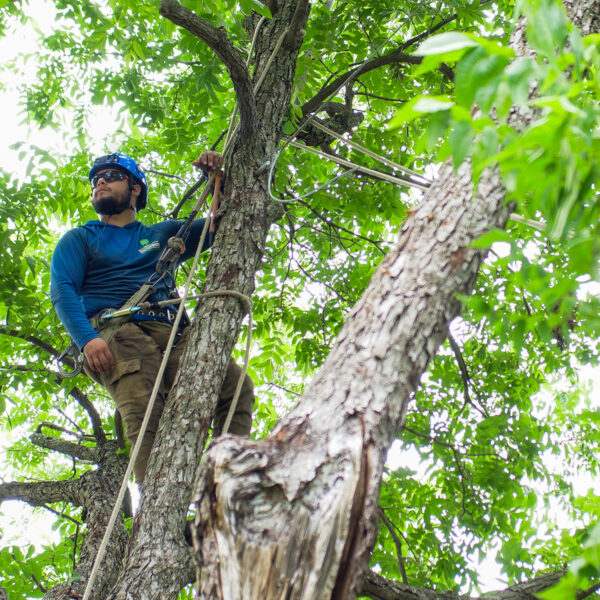
Cabling and Bracing
We Love Trees
As trees mature, some develop structural weaknesses that can lead to serious problems—split trunks, cracked limbs, or even complete failure during high winds or storms. At Texas Tree Surgeons, our ISA Certified Arborists specialize in cabling and bracing techniques that help preserve these trees, reduce risk, and extend their life.
Why Do Trees Need Cabling or Bracing?
Certain growth patterns—like tight “V” shaped unions, co-dominant stems, or overextended limbs—make trees more prone to failure. These weaknesses can worsen with time or under stress from storms, added weight, or root problems.
Cabling and bracing systems provide supplemental structural support, helping to prevent breakage, improve tree stability, and protect nearby people and property.
Our Tree Support Services
Cabling
- Purpose: To reduce excessive movement of limbs and prevent breakage.
- Method: High-strength steel cables are installed between limbs or between the trunk and major branches to redistribute mechanical stress.
- When Used: For trees with weak branch unions, long horizontal limbs, or multiple trunks prone to splitting.
Bracing
- Purpose: To provide rigid support to weak or split joints.
- Method: Threaded steel rods (through-rods or dead-end rods) are inserted through the trunk or branch union to reinforce structural integrity.
- When Used: For split trunks, narrow “V” crotches, or to stabilize previous damage.
Common Conditions We Treat
- Co-dominant stems / split trunks
- Overextended or downward-hanging limbs
- Cracks or included bark at branch unions
- Cracking at the base of multi-trunk trees
- Structural stress from recent storm damage
If you’re seeing any of these signs, schedule a consultation with one of our Certified Arborists.
Why Choose Texas Tree Surgeons?
- Certified Expertise: All assessments and installations are performed by ISA Certified Arborists.
- Standards-Based: We follow ANSI A300 guidelines and use industry-recommended materials and configurations.
- Safety-First Approach: We only recommend support systems, when necessary, after evaluating all pruning or structural reduction options.
- Preventative Care: Cabling and bracing can help you avoid costly removals or storm damage later.
Maintenance & Inspections
Tree support systems need periodic inspection to ensure continued effectiveness. Steel cables may last 20–40 years but must be monitored for wear, corrosion, or slack. We offer annual inspections for all our installed systems.
Cabling & Bracing
View Photos of our Highly Trained Crew's Getting the Job Done

SPLIT TRUNK
Split trunks are most often found on multi-trunked trees. As these trees grow, the weight increases and width of their original stems increases growing wider and wider. Eventually, these trunks will start to grow in a way that creates internal pressure along the joint at the base of the tree.






















